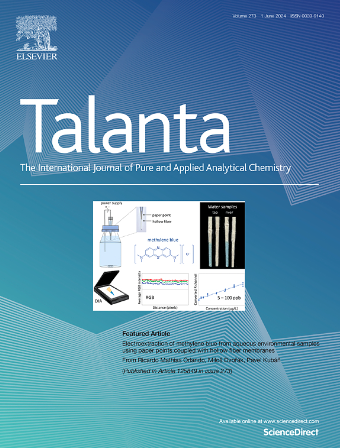基于电场和拥挤剂促进杂交的超高效无扩增生物传感器用于病原菌检测
IF 6.1
1区 化学
Q1 CHEMISTRY, ANALYTICAL
引用次数: 0
摘要
致病菌因其高传染性和致死率对公共卫生和全球经济构成重大威胁。因此,快速准确地鉴定这些细菌仍然是一个重大挑战。无电化学放大检测方法具有快速、简便、灵敏度高等优点。然而,这些方法也存在一定的缺点,如长链核酸在电极表面的固相杂交效率低下,直接检测长链核酸具有挑战性。为此,我们基于HRP信号放大原理,建立了高效、快速检测长链核酸的新型传感器平台。该平台结合了大分子拥挤剂和电场辅助,提高了临床样品中病原菌的检测效率,无需扩增。检测过程首先将目标引入含有拥挤剂的链位移反应系统。拥挤剂的拥挤效应使得长链靶标迅速取代生物素化的探针。随后,将电场施加到丝网印刷电极的表面以进行快速杂交,并用捕获探针对其进行修饰。该方法简单快捷,杂交时间从150分钟缩短到90秒。传感器平台的检测线性范围为102 ~ 107 CFU mL−1,25min内检测下限为10 CFU mL−1。该平台展示了在临床环境中现场检测致病菌的巨大潜力,并有望整合到现有的诊断设备中。本文章由计算机程序翻译,如有差异,请以英文原文为准。

Ultra-efficient amplification-free biosensor based on electric field and crowding agent-promoted hybridization for the detection of pathogenic bacteria
Pathogenic bacteria represent a significant threat to public health and the global economy due to their high infectiousness and lethality. Consequently, the rapid and accurate identification of these bacteria remains a major challenge. Electrochemical amplification-free detection methods have shown several advantages, including rapidity, simplicity and high sensitivity. However, these methods also possess certain drawbacks, such as the inefficient solid-phase hybridization of long-chain nucleic acids on the electrode surface, it is challenging to directly detect long-chain nucleic acids. In response, we have established a novel sensor platform for efficient and rapid detection of long chain nucleic acids based on the principle of HRP signal amplification. This platform incorporates macromolecular crowding agents and electric field assistance to enhance pathogenic bacteria detection efficiency in clinical samples without amplification. The detection process begins by introducing the target into a strand displacement reaction system containing a crowding agent. The crowding effect of the crowding agent is such that the long chain target rapidly replaces the biotinylated probe. Subsequently, an electric field is applied to the surface of the screen-printed electrodes for rapid hybridization, which has been modified with a capture probe. This assay is straightforward and expeditious, reducing hybridization time from 150 min to 90 s. The sensor platform showed a detection linear range of 102–107 CFU mL−1 with the limit of detection of 10 CFU mL−1 within 25min. This platform showcases the significant potential for on-site detection of pathogenic bacteria in clinical settings and is expected to be integrated into existing diagnostic equipment.
求助全文
通过发布文献求助,成功后即可免费获取论文全文。
去求助
来源期刊

Talanta
化学-分析化学
CiteScore
12.30
自引率
4.90%
发文量
861
审稿时长
29 days
期刊介绍:
Talanta provides a forum for the publication of original research papers, short communications, and critical reviews in all branches of pure and applied analytical chemistry. Papers are evaluated based on established guidelines, including the fundamental nature of the study, scientific novelty, substantial improvement or advantage over existing technology or methods, and demonstrated analytical applicability. Original research papers on fundamental studies, and on novel sensor and instrumentation developments, are encouraged. Novel or improved applications in areas such as clinical and biological chemistry, environmental analysis, geochemistry, materials science and engineering, and analytical platforms for omics development are welcome.
Analytical performance of methods should be determined, including interference and matrix effects, and methods should be validated by comparison with a standard method, or analysis of a certified reference material. Simple spiking recoveries may not be sufficient. The developed method should especially comprise information on selectivity, sensitivity, detection limits, accuracy, and reliability. However, applying official validation or robustness studies to a routine method or technique does not necessarily constitute novelty. Proper statistical treatment of the data should be provided. Relevant literature should be cited, including related publications by the authors, and authors should discuss how their proposed methodology compares with previously reported methods.
 求助内容:
求助内容: 应助结果提醒方式:
应助结果提醒方式:


